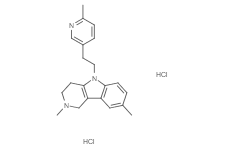
Latrepirdine
CAS No. 97657-92-6
Latrepirdine( Latrepirdine dimebolin Dimebon )
Catalog No. M17697 CAS No. 97657-92-6
Latrepirdine is an orally active, and neuroactive antagonist of multiple drug targets, including histamine receptors, GluR, and 5-HT receptors, used as an antihistamine drug.
Purity : >98% (HPLC)
 COA
COA
 Datasheet
Datasheet
 HNMR
HNMR
 HPLC
HPLC
 MSDS
MSDS
 Handing Instructions
Handing Instructions
| Size | Price / USD | Stock | Quantity |
| 5MG | 39 | Get Quote |


|
| 10MG | 77 | Get Quote |


|
| 25MG | 135 | Get Quote |


|
| 50MG | 230 | Get Quote |


|
| 100MG | 383 | Get Quote |


|
| 200MG | 528 | Get Quote |


|
| 500MG | Get Quote | Get Quote |


|
| 1G | Get Quote | Get Quote |


|
Biological Information
-
Product NameLatrepirdine
-
NoteResearch use only, not for human use.
-
Brief DescriptionLatrepirdine is an orally active, and neuroactive antagonist of multiple drug targets, including histamine receptors, GluR, and 5-HT receptors, used as an antihistamine drug.
-
DescriptionLatrepirdine, also known as dimebolin (sold as Dimebon), is an antihistamine drug which has been used clinically in Russia since 1983. Research is continuing in both Russia and western nations into potential applications as a neuroprotective drug to combat Alzheimer's disease and, possibly, as a nootropic as well. However, a Phase III clinical trial for Alzheimer's disease treatment failed to show any benefit.
-
In VitroLatrepirdine has been reported to possess several properties that are potentially relevant to the treatment of neurodegenerative diseases: (1) protection of cultured cells from the cytotoxicity of amyloid-β (Aβ) peptide; (2) stabilization of mitochondrial function and calcium homeostasis; (3) modulation of Aβ release from cultured cells, isolated intact nerve terminals, and from hippocampal neurons in living mouse brain; and (4) promotion of neurogenesis in the murine hippocampus. Treatment of cultured mammalian cells with Latrepirdine leads to enhanced mTOR- and Atg5-dependent autophagy. Latrepirdine modulates Atg5-dependent autophagic activity in a dose-dependent manner and via the mTOR-signaling pathway. HeLa cells stably expressing LC3 fused are treated with EGFP (eGFP-LC3) for 3 or 6 hours in the absence or presence of 50 μM Latrepirdine. Treatment with Latrepirdine for 3 or 6 hours markedly enhances the number of eGFP-LC3 punctae, indicating that Latrepirdine induces formation of autophagosomes. Next, mouse N2a neuroblastoma cells are treated in the absence (vehicle) or presence of 5 nM, 500 nM or 50 μM Latrepirdine for 3 or 6 hours in order to determine the effects of acute drug treatment on the regulation of autophagy. A significant and dose-dependent increase is observed in LC3-II levels in N2a cells following 3- or 6-hour treatment with either 500 nM or 50 μM Latrepirdine. A significant decrease of p-mTOR and p-S6K from N2a cells treated with 50 μM Latrepirdine for 3 hours is observed, whereas the total mTOR and p70S6K levels remain relatively constant.
-
In VivoLatrepirdine treatment of TgCRND8 transgenic mice is associated with improved learning behavior and with a reduction in accumulation of Aβ42 and α-synuclein. Male, 90-day-old TgCRND8 mice or their wild-type littermates (nTg) receive 31 consecutive once daily i.p. injections of either 3.5 mg/kg Latrepirdine or 0.9% saline (vehicle). At the culmination of treatment, mice are tested for cued and contextual fear conditioning using a paradigm that has been widely accepted for evaluating learning and memory deficits in APP transgenic mice. A significant increase in cued memory only among Latrepirdine-versus vehicle-treated TgCRND8 mice (p=0.01) is observed. A weak, non-significant trend toward an improvement in contextual memory among Latrepirdine-versus vehicle-treated mice (p=0.099) is also observed.
-
SynonymsLatrepirdine dimebolin Dimebon
-
PathwayOthers
-
TargetOther Targets
-
RecptorGluR , Histamine receptor , 5-HT
-
Research AreaInflammation/Immunology
-
Indication——
Chemical Information
-
CAS Number97657-92-6
-
Formula Weight392.37
-
Molecular FormulaC21H25N3·2HCl
-
Purity>98% (HPLC)
-
SolubilityDMSO : 6.4 mg/mL. 16.31 mM;
-
SMILESCC1=CC2=C(C=C1)N(C3=C2CN(CC3)C)CCC4=CN=C(C=C4)C.Cl.Cl
-
Chemical Name2,8-dimethyl-5-(2-(6-methylpyridin-3-yl)ethyl)-2,3,4,5-tetrahydro-1H-pyrido[4,3-b]indole hydrochloride
Shipping & Storage Information
-
Storage(-20℃)
-
ShippingWith Ice Pack
-
Stability≥ 2 years
Reference
1. Zhang S, et al. J Alzheimers Dis, 2010, 21(2), 389-402.
molnova catalog



related products
-
Rhoifolin
Rhoifolin is extracted from Turpinia arguya Seem dried leaves.
-
[Tyr0] Gastric Inhib...
[Tyr0] Gastric Inhibitory Peptide (23-42), human; [Tyr22] Gastric Inhibitory Peptide (22-42), human
-
Fmoc-D-Thr(Po(Obzl)O...
——



 Cart
Cart
 sales@molnova.com
sales@molnova.com


